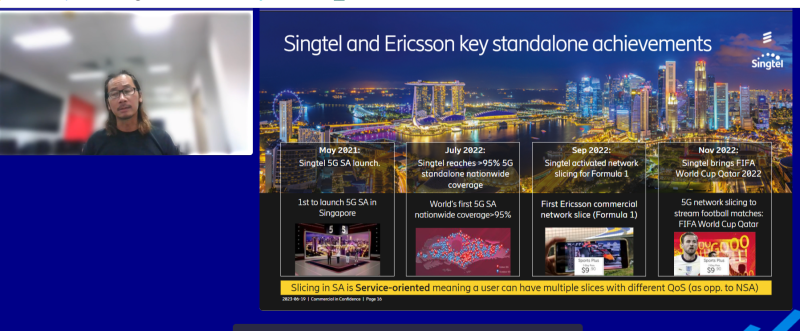The debate over how many operators have deployed standalone (SA) rages on with Ericsson weighing in this week via its 2023 Mobility Report.
According to vendor's report, around 35 operators have deployed or launched 5G standalone (SA). That’s less than the 43 operators Dell’Oro Group counted as of Q1 2023. But the figure doesn’t necessarily contradict ABI Research’s assertion that commercial SA deployments have lagged in North America and Europe compared to Asia given Ericsson highlighted cloud-native 5G SA as part of the Mobility Report, and showcased Singapore as the first country in the world to be fully covered by 5G SA.
“Many SA deployments are carried out in a stepwise fashion,” the report states. “With increased carrier aggregation capabilities in networks and devices, the SA proposition is now deemed to be on par with [non-standalone] in terms of data rates, while adding to the many benefits of the new 5G core network.
Slicing it up in Singapore
One of the reasons 5G SA is so important is that it fully enables network slicing. Aside from Singapore’s Singtel, Silverlinings has only seen commercial 5G network slicing from Telstra so far. This will start to change by the end of this year but not much before.
Indeed, during a webinar associated with the report on June 21, 2023, Richard Moller, senior market analyst at Ericsson, said it will take two years for European operators to offer widespread 5G SA coverage. Meanwhile, all four major U.S. operators have already launched 5G SA services.
During the webinar, Singapore's Singtel promoted the fact that they are one of the very few mobile network operators (MNOs) in the world offering commercial 5G network slicing. Together with Ericsson, Singtel launched a 5G SA network in the 710- square kilometer city-state in May 2021, and then used the first post-pandemic Formula 1 Grand Prix race in September 2022 to try to slice ‘n’ dice its pure 5G network to deliver high-quality video streams, according to Ericsson.
The report noted that thanks to network slicing, premium subscribers at the race enjoyed data download speeds of 437 Mbps on average.
Singtel repeated this slicing speed trick for 5G video streams for the Qatar world cup in December 2022.
Offering premium video streaming using network slicing will clearly be key consumer offering for early network slicing applications. “We’re only able to do that on the 5G standalone network,” Cheong Hai Thoo (also referred to as “Hi2”), VP of mobile engineering at Singtel, said on the webinar.

Even most of the 35-plus operators that have launched 5G SA networks so far haven’t yet started to offer network slicing yet.
Aside from Singtel, Silverlinings has only seen commercial 5G network slicing from Telstra so far. This will start to change by the end of this year but not sooner.
“We have commercial customers employing network slicing,” Thoo said. “You can have economy of scope, with multiple uses on the same network,” he commented.
Because Singtel was so early in deploying network slicing though, it is looking to update its static slicing – fixed slices for perpetual usage – to dynamic slicing over time, he added.
Ericsson’s 5G getaway
Of course, the Ericsson report highlighted many other aspects of the 5G landscape. These include:
-
5G mobile subscriptions are set to reach 1.5 billion globally by the end of 2023. In the first quarter, 125 million subscriptions were added.
-
Revenue is rising for service providers in the top 20 5G markets, increasing 7% in the last two years alone.
-
Mobile network data traffic grew 36% between Q1 2022 and Q1 2023.
-
In 2027, all mobile data traffic growth will come from 5G, as 4G traffic declines.
-
In 2028, 5G will account for almost 80% of fixed-wireless access (FWA) connections, and FWA will represent 30% of global mobile data traffic.
-
5G population coverage has reached 35%.
Do you want to learn more about the cloud-native 5G market? Sign up to attend our virtual Cloud-Native 5G Summit today.

